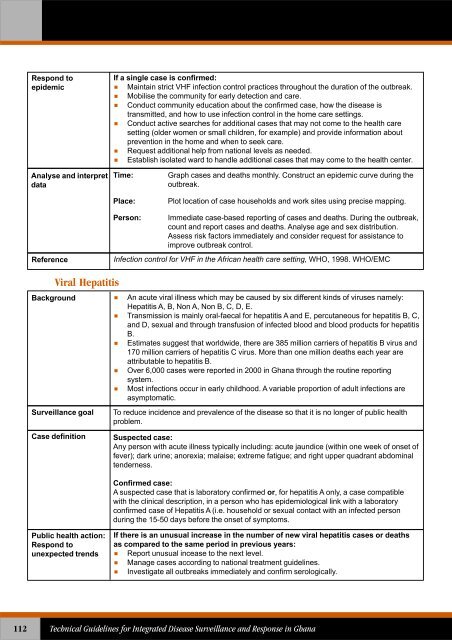Technical Guidelines for Integrated Disease Surveillance ... - PHRplus
Technical Guidelines for Integrated Disease Surveillance ... - PHRplus
Technical Guidelines for Integrated Disease Surveillance ... - PHRplus
You also want an ePaper? Increase the reach of your titles
YUMPU automatically turns print PDFs into web optimized ePapers that Google loves.
Respond toepidemicAnalyse and interpretdataIf a single case is confirmed: Maintain strict VHF infection control practices throughout the duration of the outbreak. Mobilise the community <strong>for</strong> early detection and care. Conduct community education about the confirmed case, how the disease istransmitted, and how to use infection control in the home care settings. Conduct active searches <strong>for</strong> additional cases that may not come to the health caresetting (older women or small children, <strong>for</strong> example) and provide in<strong>for</strong>mation aboutprevention in the home and when to seek care. Request additional help from national levels as needed.Establish isolated ward to handle additional cases that may come to the health center.Time:Graph cases and deaths monthly. Construct an epidemic curve during theoutbreak.Place:Plot location of case households and work sites using precise mapping.ReferencePerson:Immediate case-based reporting of cases and deaths. During the outbreak,count and report cases and deaths. Analyse age and sex distribution.Assess risk factors immediately and consider request <strong>for</strong> assistance toimprove outbreak control.Infection control <strong>for</strong> VHF in the African health care setting, WHO, 1998. WHO/EMCViral HepatitisBackground An acute viral illness which may be caused by six different kinds of viruses namely:Hepatitis A, B, Non A, Non B, C, D, E. Transmission is mainly oral-faecal <strong>for</strong> hepatitis A and E, percutaneous <strong>for</strong> hepatitis B, C,and D, sexual and through transfusion of infected blood and blood products <strong>for</strong> hepatitis<strong>Surveillance</strong> goalB.Estimates suggest that worldwide, there are 385 million carriers of hepatitis B virus and170 million carriers of hepatitis C virus. More than one million deaths each year areattributable to hepatitis B.Over 6,000 cases were reported in 2000 in Ghana through the routine reportingsystem.Most infections occur in early childhood. A variable proportion of adult infections areasymptomatic.To reduce incidence and prevalence of the disease so that it is no longer of public healthproblem.Case definitionSuspected case:Any person with acute illness typically including: acute jaundice (within one week of onset offever); dark urine; anorexia; malaise; extreme fatigue; and right upper quadrant abdominaltenderness.Confirmed case:A suspected case that is laboratory confirmed or, <strong>for</strong> hepatitis A only, a case compatiblewith the clinical description, in a person who has epidemiological link with a laboratoryconfirmed case of Hepatitis A (i.e. household or sexual contact with an infected personduring the 15-50 days be<strong>for</strong>e the onset of symptoms.Public health action:Respond tounexpected trendsIf there is an unusual increase in the number of new viral hepatitis cases or deathsas compared to the same period in previous years: Report unusual incease to the next level. Manage cases according to national treatment guidelines.Investigate all outbreaks immediately and confirm serologically.112<strong>Technical</strong> <strong>Guidelines</strong> <strong>for</strong> <strong>Integrated</strong> <strong>Disease</strong> <strong>Surveillance</strong> and Response in Ghana















